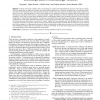Free Online Productivity Tools
i2Speak
i2Symbol
i2OCR
iTex2Img
iWeb2Print
iWeb2Shot
i2Type
iPdf2Split
iPdf2Merge
i2Bopomofo
i2Arabic
i2Style
i2Image
i2PDF
iLatex2Rtf
Sci2ools
VIS
2009
IEEE
2009
IEEE
An Interactive Visualization Tool for Multi-channel Confocal Microscopy Data in Neurobiology Research
Confocal microscopy is widely used in neurobiology for studying the three-dimensional structure of the nervous system. Confocal image data are often multi-channel, with each channel resulting from a different fluorescent dye or fluorescent protein; one channel may have dense data, while another has sparse; and there are often structures at several spatial scales: subneuronal domains, neurons, and large groups of neurons (brain regions). Even qualitative analysis can therefore require visualization using techniques and parameters fine-tuned to a particular dataset. Despite the plethora of volume rendering techniques that have been available for many years, the techniques standardly used in neurobiological research are somewhat rudimentary, such as looking at image slices or maximal intensity projections. Thus there is a real demand from neurobiologists, and biologists in general, for a flexible visualization tool that allows interactive visualization of multi-channel confocal data, with...
Confocal Image Data | Multi-channel Confocal Data | Multi-channel Volume Data | VIS 2009 | Visualization |
| Added | 06 Nov 2009 |
| Updated | 14 Nov 2009 |
| Type | Conference |
| Year | 2009 |
| Where | VIS |
| Authors | Yong Wan, Hideo Otsuna, Chi-Bin Chien, Charles Hansen |
Comments (0)

